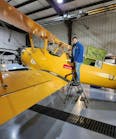USHST’s Infrastructure Working Group Completes 6th Annual Helicopter Infrastructure Summit in Washington, D.C.
The 6th annual U.S. Helicopter Safety Team Infrastructure Summit was held Mar. 12-13 with 55 participants representing more than 40 industry and government entities. They included OEM’s, operators, the FAA, associations, and safety experts.
Attendees of the USHST Infrastructure Summit work cooperatively in a round table format to develop new helicopter safety strategies for enhancing critical low-level infrastructure needs as they relate to low-level IFR operations, weather reporting, and heliport design. The group’s primary goal is to promote the use of new technologies and intervention strategies that address the top causes of fatal accidents. These causes include unintended flight into instrument meteorological conditions, loss-of-control, and controlled flight into terrain.
Day one of the Summit kicked off with these topics:
- A safety update from USHST steering committee members: Airbus’ Manny Figlia and Bell’s Tony Randall;
- A deep dive into the latest proposed changes to the FAA’s Heliport Design guide from Robert Bassey of the FAA;
- A status report on the FAA’s Airport Master Record digital project from the FAA’s Chris Criswell;
- Leonardo’s Bill Sunick provided an update on the 609 Tilt rotor Project as it relates to future needs;
- Mike Hirschberg, Executive Director of the Vertical Flight Society, highlighted many of the advancements, and soon to be infrastructure requirements, for Electrical Vertical Takeoff & Landing (eVTOL) aircraft.
Of particular interest to many in day one’s afternoon session was the discussion surrounding the progress on single engine IFR operations lead by Tony Randall of Bell and Enso Galli of Leonardo. According to Manny Figlia of Airbus, “The Working Group’s identification for the need for single engine IFR-capable helicopters links directly to two of the USHST’s ‘Helicopter Safety Enhancements’ (H-SEs), H-SE 70 the integration of Stability Augmentation Systems and H-SE 127 Training Recognition and Recovery from Special Disorientation, as well as indirectly to H-SE 82 Helicopter Flight Data Monitoring and H-SE 115/128 Threat Error Management for Recurrent Pilot Training.”
Mike Webb and Cliff Johnson of the FAA provided an in-depth discussion on the need for clear and concise guidance on heliport ‘Survey Standards’ and the critical role this plays in providing safe and cost effective low-level IFR and VFR infrastructure to helicopter operators.
Day one wrapped up with the FAA’s Nolan Crawford facilitating a discussion on IFR infrastructure opportunities and Dave Burr from LifeFlight of Maine speaking about the importance of low-level IFR infrastructure and its benefits to the Helicopter Air Ambulance (HAA) community.
Day Two was dedicated to low-level weather reporting.
It began with an update from Stephanie Avey of NOAA’s Aviation Weather Center on the status of the next generation of the HEMS Weather Tool, due to be released this spring.
- This was followed by an in-depth review from Rune Duke of AOPA on how the FAA Reauthorization Act of 2018 is impacting surface weather observation policies in the U.S. as it pertains to such things as modernizing AWOS standards, non-federal AWOS applications, and Weather Camera research and implementation.
- Next came a comprehensive review by Chris Baur, CEO of Hughes Aerospace Corp., on advancements in IFR navigation solutions and integration of camera equipped weather stations by third-party air navigation service providers.
Matthias Steiner, director of aviation applications program at the National Center for Atmospheric Research (NCAR), commented that “weather continues to challenge low-level off-airport operations, especially near thunderstorms, in complex terrain, urban environments, and areas with significant variance in land surface characteristics like land/water contrast, agriculture versus forests, etc. Such areas may exhibit notable local and diurnally varying weather phenomena related to winds, turbulence, clouds and precipitation, that can affect the safety and efficiency of low-level flight operations.”
